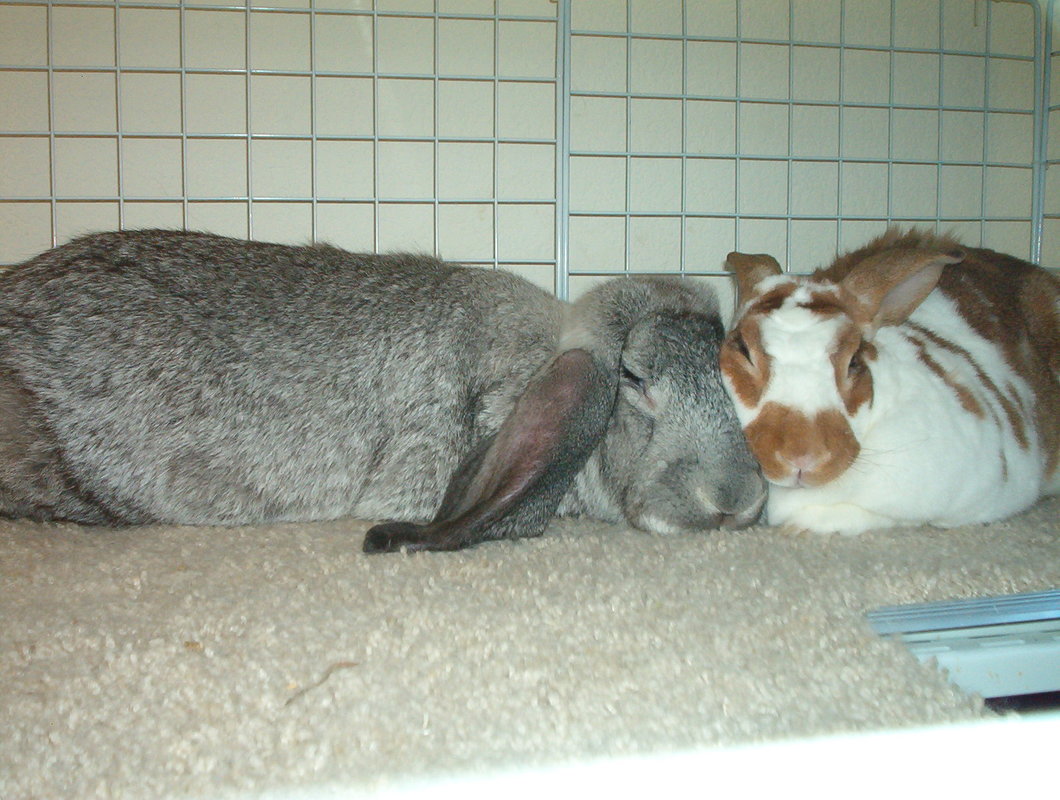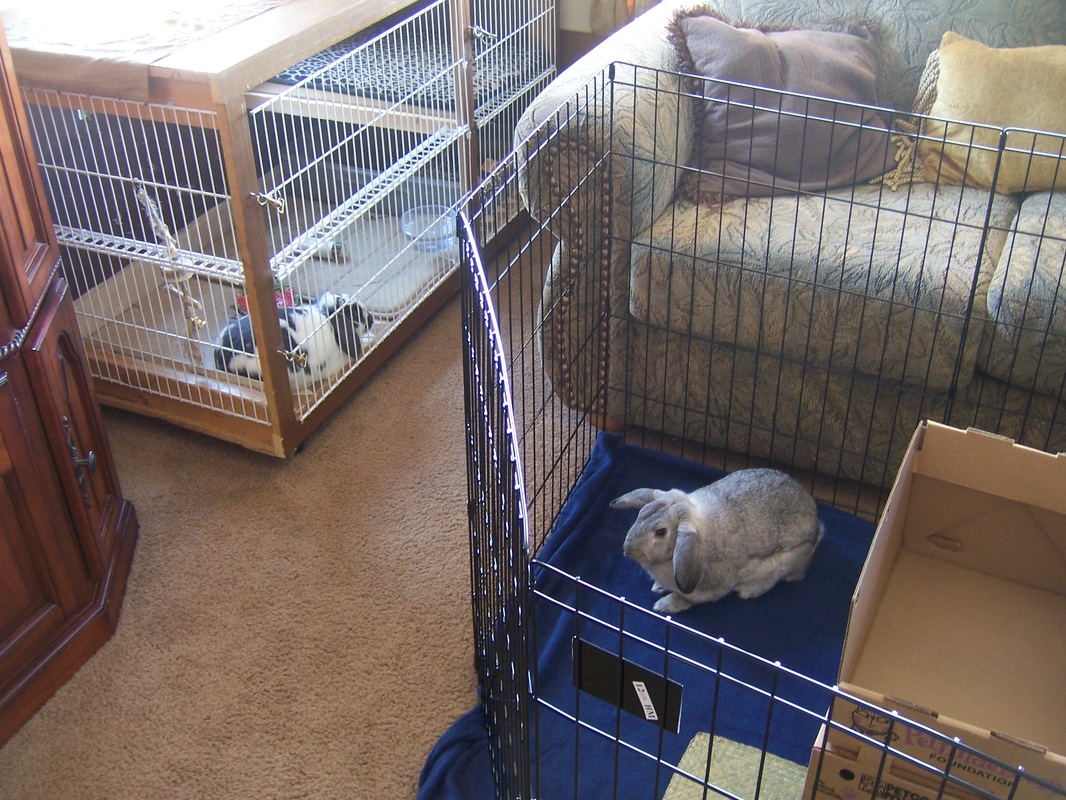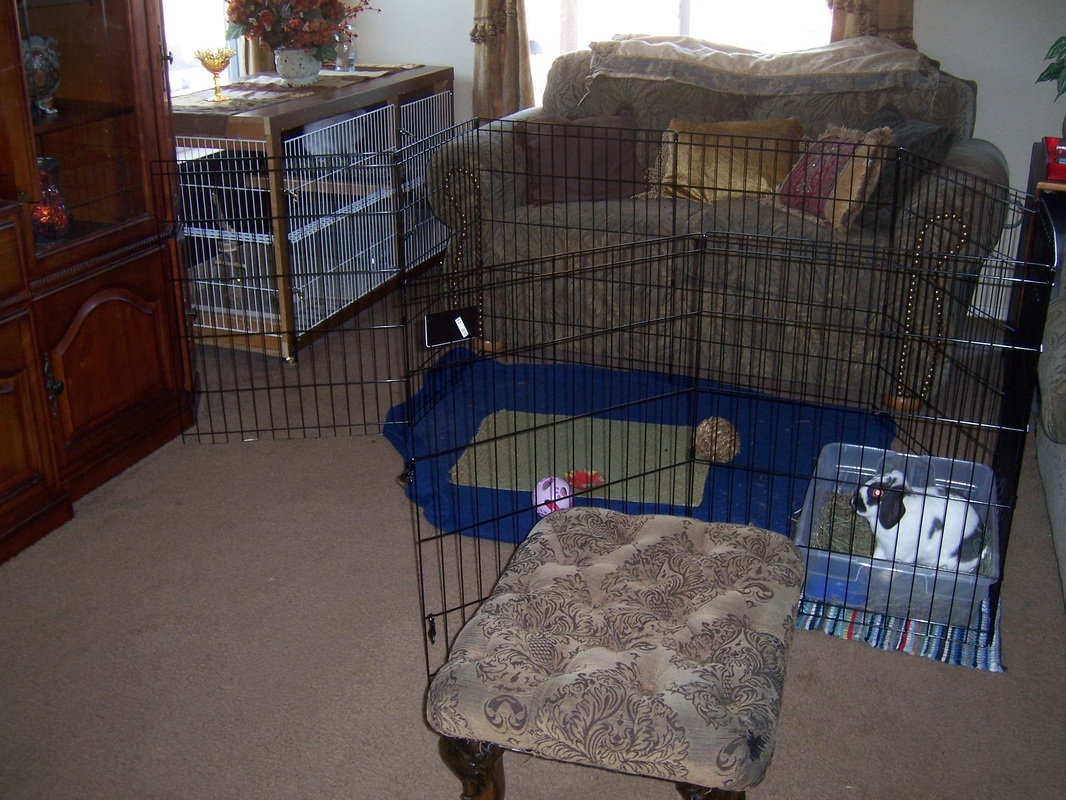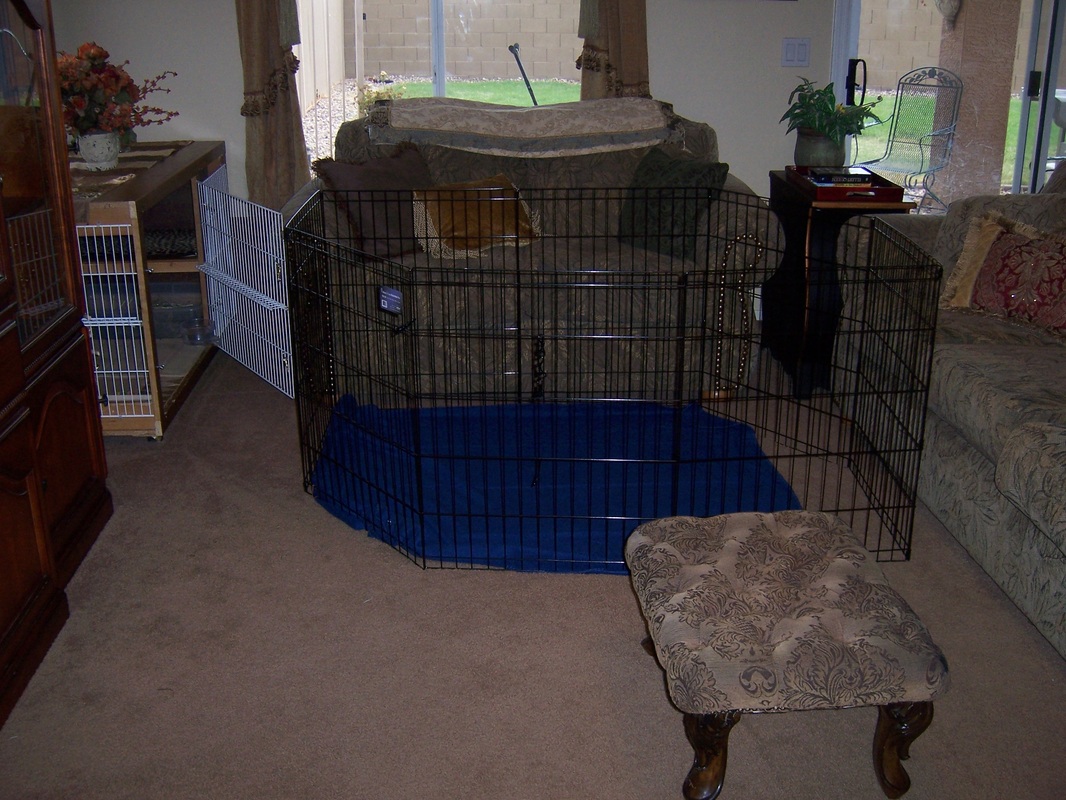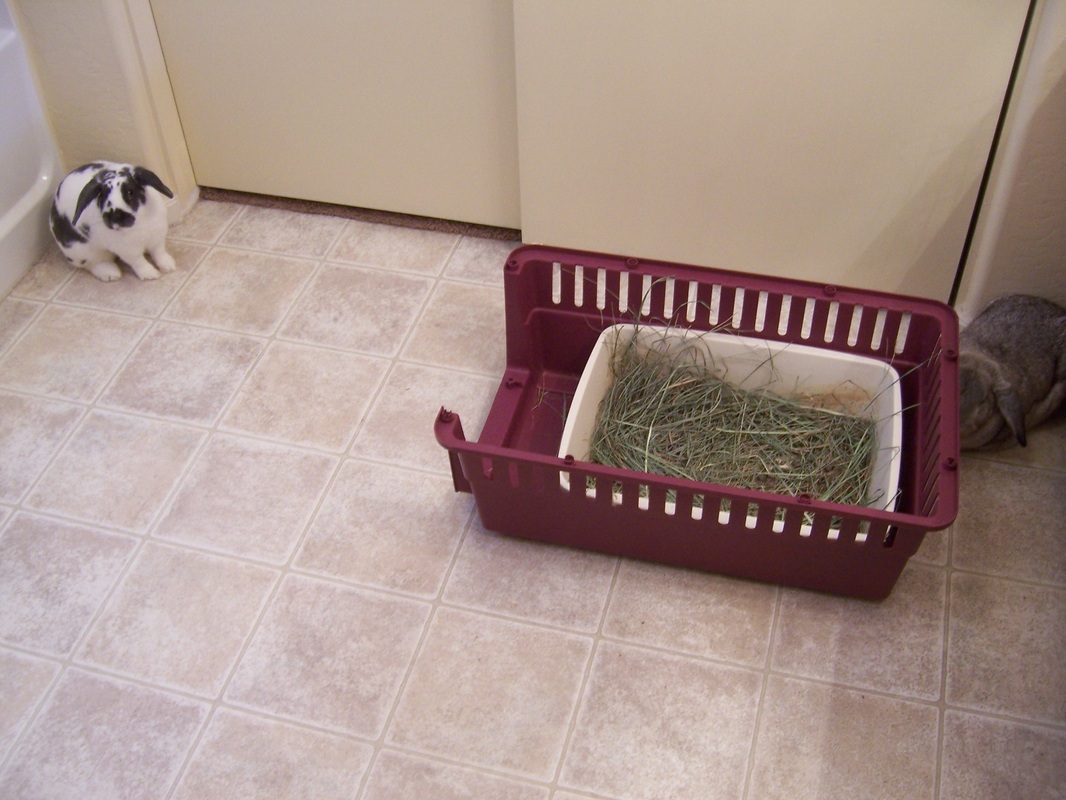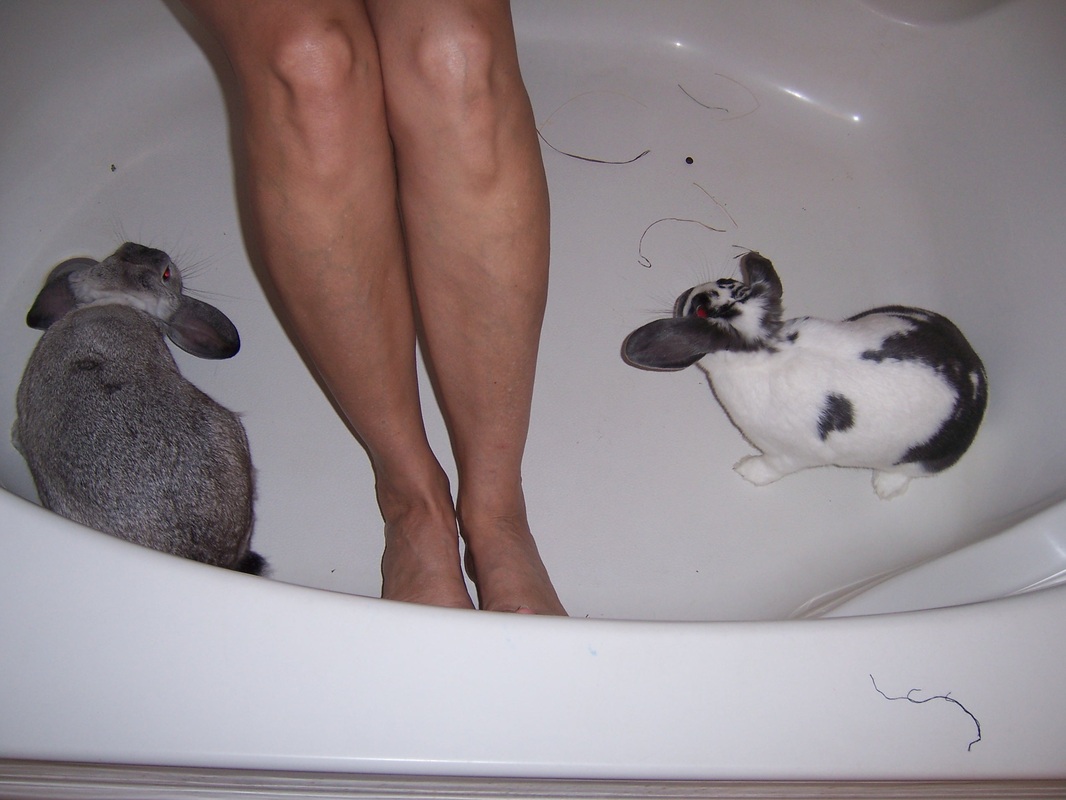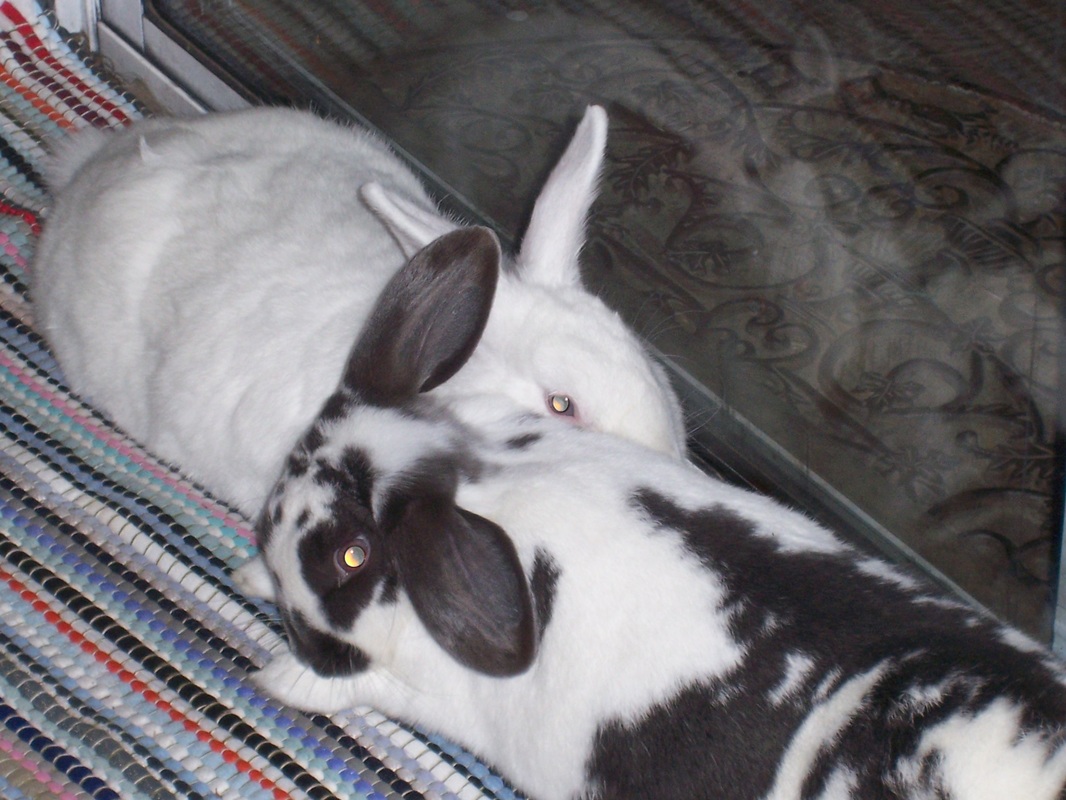Bonding Bunnies:
[ Tablet users, try the "web" version by clicking on "web" at the bottom of this page for a better, user-friendly format. ]
|
Many are surprised to discover that one cannot simply place 2 rabbits together and expect them to get along. Rabbits must be carefully introduced and monitored and, perhaps, if they are willing, they will decide to get along and bond.
|
The true bond: Spayed or neutered rabbits bond best. Male/female pairs are considered easiest. Male/male are considered more difficult. BOTH rabbits should be fixed to increase the chance of a long-lasting bond. It's not a matter of just preventing pregnancy. It's a matter of having those hormones kept in check. The rare bonds that do occur with intact rabbits often end up broken for seemingly no apparent reason -- sometimes even after a few years of apparent bonded bliss. Even with altered rabbits, it's best to do your research before attempting to bond 2 rabbits.
|
[The preferred method to finding a bondmate is to go through a rabbit rescue to pre-screen for potential compatibility. However, if you live in an area affected by the RHDV outbreak, be sure to quarantine any new potential bondmate for 2 weeks before beginning any bonding attempts. Speak with your local rabbit rescue for advice concerning what to do regarding the virus.]
|
Simply put, to bond two rabbits, they should both be fixed.
If you have a rabbit that has recently been fixed, allow time after surgery for healing. Females should wait a month after surgery before bonding. Males should wait about 6 weeks, possibly 8 weeks, to allow those hormones to fully dissipate. Hormones can interfere with bonding and set back or prevent a bond. For the best chance of success, don't start the bonding process too soon after surgery.
Easiest way to find a bondmate for your rabbit
The least stressful way to find a bondmate for your rabbit is to introduce your fixed rabbit to other fixed rabbits at a rabbit rescue.
Find a rescue and let them know that you are looking for a bondmate. They will help guide you through the process.
Since their rabbits are already fixed, you'll be able to pre-screen for potential compatibility.
Once you bring the new guy (or gal) home, you can begin the bonding process (see detail below for this process).
The big advantage to working with a rescue is that you can let them know if you are running into trouble with the bonding process. If the two rabbits are not getting along, they can offer suggestions and guidance. If it ends up that the two rabbits just won't get along, the rescue typically will allow an exchange. This is something that a generic shelter won't allow (generally speaking). There is a rescue I have worked with that, with a particularly stubborn female rabbit, provided me two exchanges before a 3rd rabbit finally bonded with her.
This exchange policy is such a huge advantage for any bunny owner that is looking for a bondmate for their rabbit.
Bear in mind, that this advantage is quite lost if one gets a rabbit elsewhere. A generic shelter may have fixed rabbits, but generally won't allow an exchange. A breeder won't have fixed rabbits so a rabbit from there will first need to be fixed. That would be quite a cost commitment with no guarantee in the end that the new rabbit will bond. So in getting a rabbit from either a generic shelter or a breeder (or private owner), if the bond doesn't take, one is left in a predicament of having two single rabbits and failing the goal of finding a bondmate.
Find a rescue and let them know that you are looking for a bondmate. They will help guide you through the process.
Since their rabbits are already fixed, you'll be able to pre-screen for potential compatibility.
Once you bring the new guy (or gal) home, you can begin the bonding process (see detail below for this process).
The big advantage to working with a rescue is that you can let them know if you are running into trouble with the bonding process. If the two rabbits are not getting along, they can offer suggestions and guidance. If it ends up that the two rabbits just won't get along, the rescue typically will allow an exchange. This is something that a generic shelter won't allow (generally speaking). There is a rescue I have worked with that, with a particularly stubborn female rabbit, provided me two exchanges before a 3rd rabbit finally bonded with her.
This exchange policy is such a huge advantage for any bunny owner that is looking for a bondmate for their rabbit.
Bear in mind, that this advantage is quite lost if one gets a rabbit elsewhere. A generic shelter may have fixed rabbits, but generally won't allow an exchange. A breeder won't have fixed rabbits so a rabbit from there will first need to be fixed. That would be quite a cost commitment with no guarantee in the end that the new rabbit will bond. So in getting a rabbit from either a generic shelter or a breeder (or private owner), if the bond doesn't take, one is left in a predicament of having two single rabbits and failing the goal of finding a bondmate.
Pre-bonding
One option available before beginning the actual bonding process is to allow two rabbits to live in side-by-side (not touching) enclosures for a period of time -- days or weeks, depending on the individual rabbits. This can be done before beginning either of the two bonding methods described below.
Two different approaches to bonding rabbits.
Over the years, I have personally dealt with some difficult bonds. A few rabbits were very particular about who they would accept. Several rabbit rescues with whom I have dealt here in the US have recommended the gradual approach (redirects to another site) to bonding buns.
In doing further research regarding a particularly difficult female of mine, I stumbled across what I refer to as the "immersion approach" (redirects to another site) to bunny bonding. This method I found on a UK site. They refer to it as the "fast track method."
I have used both methods successfully. With some rabbits, the "gradual approach" could actually be the best (quickest) way for those particular rabbits to get along. Which method you choose depends on what you feel most comfortable with and confident in. A combination of these two is also possible. Begin with the gradual approach and then switch to the immersion approach. After all the research, much of bunny bonding boils down to following your gut instinct. You know your rabbit and need to trust your feelings of what seems to be working.
Note: I used to refer to these methods as the "slow" and "fast" approaches. The titles didn't seem to quite fit. I now refer to them as "gradual" and "immersion."
(1) The "gradual method" means short sessions over a longer period of time.
(2) The "immersion method" means the rabbits are placed together in a specifically designed space and monitored closely and continually. They are not removed from that area until bonded (or it is determined that they won't bond.)
In doing further research regarding a particularly difficult female of mine, I stumbled across what I refer to as the "immersion approach" (redirects to another site) to bunny bonding. This method I found on a UK site. They refer to it as the "fast track method."
I have used both methods successfully. With some rabbits, the "gradual approach" could actually be the best (quickest) way for those particular rabbits to get along. Which method you choose depends on what you feel most comfortable with and confident in. A combination of these two is also possible. Begin with the gradual approach and then switch to the immersion approach. After all the research, much of bunny bonding boils down to following your gut instinct. You know your rabbit and need to trust your feelings of what seems to be working.
Note: I used to refer to these methods as the "slow" and "fast" approaches. The titles didn't seem to quite fit. I now refer to them as "gradual" and "immersion."
(1) The "gradual method" means short sessions over a longer period of time.
(2) The "immersion method" means the rabbits are placed together in a specifically designed space and monitored closely and continually. They are not removed from that area until bonded (or it is determined that they won't bond.)
Gradual Method of Bonding
Below are some photos of the gradual method in progress. For details on how this bonding approach works, click on the following site:
The House Rabbit Network (clicking here will take you to another website)
The House Rabbit Network (clicking here will take you to another website)
Immersion Method of Bonding
To see the immersion approach method in action and to get an idea of what to expect when bonds are going well, not going well, or ones that just won't work, take a peek at Cottontails Rescue site. The enclosures they used for this method are outdoors, but will still show how this method is done by providing multiple video examples.
The videos on this page (below) show how this same method can be used in an indoor setting just as easily.
Please note: My videos below are actually for attempting a trio of buns (all spayed & neutered). A three-way bond is very difficult, but I tried it in my stubbornness anyway. For 4 weeks they only had minor scuffles, but after that, the 2 brothers became irreconcilable. The female did maintain a bond with one of the boys and those 2 remain bonded. I have included the videos only for the purpose of showing an indoor set-up for this type of bonding method. I do not recommend attempting a trio unless you have extensive experience with bonding rabbits.
You may have noticed that the white and gray female below is the same rabbit as in the above photos. She was a particularly choosey girl. The bond attempt with the gray lop above did not work out. Below, she ultimately accepted one of the brothers.
The videos on this page (below) show how this same method can be used in an indoor setting just as easily.
Please note: My videos below are actually for attempting a trio of buns (all spayed & neutered). A three-way bond is very difficult, but I tried it in my stubbornness anyway. For 4 weeks they only had minor scuffles, but after that, the 2 brothers became irreconcilable. The female did maintain a bond with one of the boys and those 2 remain bonded. I have included the videos only for the purpose of showing an indoor set-up for this type of bonding method. I do not recommend attempting a trio unless you have extensive experience with bonding rabbits.
You may have noticed that the white and gray female below is the same rabbit as in the above photos. She was a particularly choosey girl. The bond attempt with the gray lop above did not work out. Below, she ultimately accepted one of the brothers.
|
An indoor set-up for the immersion approach to bonding. Note the various boxes and hiding areas that provide different "areas." This is neutral territory for all buns.
|
Grooming is typically a very good sign showing progress in the bonding.
|
No guarantees:
Even with the best planning and the most careful introductions, there is no guarantee that any two rabbits will actually get along and bond. One can do "everything right" but still end up with two stubborn bunnies that refuse to get along. Bonding is ultimately up to the rabbits. The best we can do is provide the environment to help encourage them to bond.
So don't be discouraged if you happen to experience this difficulty. Some people get lucky where they do little more than put their two rabbits together. Sometimes it can go this smoothly. But if it does not, that doesn't necessarily mean that you did anything wrong. Some rabbits just bond easily while others do not. Often it is just a matter of finding the "right" match.
So don't be discouraged if you happen to experience this difficulty. Some people get lucky where they do little more than put their two rabbits together. Sometimes it can go this smoothly. But if it does not, that doesn't necessarily mean that you did anything wrong. Some rabbits just bond easily while others do not. Often it is just a matter of finding the "right" match.




